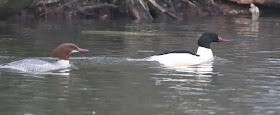Every student next term (weather permitting) will be visiting a special urban location to see a bird you don't really expect to see in a busy urban park: a Goosander. In the breeding season, as far as I am aware, there are no Goosanders to be found in the whole of East Yorkshire - the nearest are probably those breeding on the River Wharfe near Bolton Abbey. However, they move south and east in the autumn until there can be quite good numbers in these lowland counties.
A Pair of Goosanders
Most years around the end of October, especially if the weather is cold the first Goosanders begin to arrive. Numbers slowly build throughout November and December until there can be nearly 30 individuals present.
2 drakes
Goosanders are striking-looking ducks, much larger than Mallards. The drakes appear to have very dark, possibly black heads, but in good light it is possible to tell that they have bottle-green heads. They have dark upperparts too, but their breast and underparts are much paler. In individuals this can look white, or cream, but others have almost a rosy glow to them. The females have a chestnut head with a shaggy crest at the rear, a white chin, and a grey body with white on the breast.
Drake - showing bottle-green head
a pair
Female - wing markings
female Goosander landing - tiny file
Female Goosander - tiny file (c) 2015 Aileen Urquhart
Just occasionally the birds may be seen flying between one lake and another, and again they look pretty amazing with their long necks and large areas of white on the wings. However, they are very difficult to photograph flying in a busy, heavily wooded park.
Drake in flight
Both genders have a long, thin red bill (blood-red in the case of the drake) with a sharp hook on its tip. This bill also has a serrated edge which in conjunction with the hook means that they are extremely efficient at catching large fish species. The serrated bill separates Goosanders from most other UK duck species, so they, with Red-breasted Mergansers, and Smew are collectively known as sawbills. We used to see the much smaller Smew most winters, but these have become much harder to locate in recent years, but we've only seen Red-breasted Mergansers twice in the 12 years the courses have been running. However, we make an annual trip to see these obliging urban Goosanders.
Immature on ice
The numbers of these stunning wildfowl probably peak in January, but they can be affected by an over busy park or bad weather. If we have several days of severe frost then they will be forced off the lakes and may be seen on Holderness drain instead, but they may even be forced further afield to larger areas of flowing water.
Immature
Two daughters once purchased the winter term as a Christmas present for their father. On Christmas Day they asked where his first class was to be, and he answered in a very disappointed voice "East Park!" However, he was no longer disappointed after he'd actually been shown the wide variety of birds in East Park. Similarly, a retired policeman looking down his schedule was dreading the visit to East Park, but found the actual experience to be a highlight of the winter term: Goosanders, Redpolls, Goldcrests, Pink-footed Geese, Great Spotted Woodpecker, Jays and surprise, surprise a pair of Sparrowhawks sitting side-by-side. What surprises will be in store this year when we go looking for the Goosanders again?....
Female [left] & male Sparrowhawks












No comments:
Post a Comment